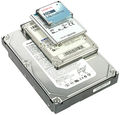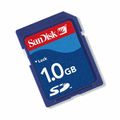Laptop Evaluation Checklist
1. Data security check
We are responsible for securely wiping or destroying any storage device that is donated to Free Geek. This commonly means removing hard drives to be wiped, but keep an eye out for other kinds of data storage devices as well.
What to keep in mind when removing hard drives
☐ Make sure to separate any caddy parts and adapters from the hard drive.
☐ Tape any caddy parts, adapters, and screws together back inside the hard drive bay. These should stay with the system unless your instructor needs them for parts.
☐ Only ever leave hard drives and other storage devices in a designated box or with your instructor.
Check for disks and other storage media
☐ Check the optical drive for disks.
- Look for the small quick-release hole on the faceplate, and use a paperclip to manually open the drive.
☐ Take a quick look for other kinds of media, let your instructor know if you find anything.
Commonly encountered storage devices:
- 3.5" hard drives (Desktop size)
- 2.5" hard drives (Laptop size)
- Optical disks
Less commonly encountered storage devices:
- 1.8" and other odd-sized small form-factor hard drives
- Mini PCI or mini PCIe solid state drives
- Small media cards (SD, Compact Flash, etc)
- SIM cards
- Floppy disks
- PCMCIA (PC Card) hard drives
- Examples
2. Physical Evaluation
☐ Take a good look at the laptop you are evaluating. Start by looking for:
- A floppy drive
- Missing cover plates from the back of the laptop
- Missing battery or optical drives
- Missing keyboard or keys
- Cracked case parts or broken hinges
- Damaged ports
- Visible screen damage
- This appears as hairline cracks or dark splatter-like marks inside the screen.
- Oxidation or evidence of liquid spills
☐ Stop here and check with your instructor if you find anything from the list. They may have you follow the Recycling or As-Is Checklist instead.
3. Find an appropriate AC adapter
Requirements
For an AC adapter to power the device correctly, it must:
- Match the input voltage (V) of the laptop exactly.
- Match or exceed the recommended amperage (A).
- Have a plug that fits into the laptop snugly and provides power.
☐ Find the input voltage and amperage listed on the laptop. This may be printed on the back of the laptop, or on the chassis under the battery.
☐ Find an AC adapter that matches the voltage and amperage listed on the laptop. You will be looking in the output section printed on the AC adapter, which should look like this:
INPUT: 100-240V~1.9A
50/60Hz
OUTPUT: 16V ⎓ 4.5A
Tip
AC adapters are sorted in bins by voltage, amperage, and brand; the bins are color-coded by brand.
4. POST
☐ Try turning the machine on.
- If the system loads the BIOS splash screen, you can move to the next step.
- If the system does not boot, or appears to have video problems, use the Laptop POST Troubleshooting Guide (A-1) in the Appendix.
5. Determine Specifications
For determining system specs, Free Geek now has a CPU Lookup tool accessible from the Laptop Network Boot menu.
- Access the Network Boot menu:
- Make sure you have a working network cable plugged into the laptop.
- Power on the laptop.
- Use the Network Boot key (usually F12) or Boot Device Menu (F9, F10, or F12) if available. If these are unavailable, enter the BIOS and make sure Network/PXE/LAN boot is enabled, then save and exit. The system should now boot from the network.
- Select Laptop Build from the menu.
- Select CPU Lookup. The CPU Lookup tool will now try to match the CPU detected in the system with information in our database. If it finds a match, it will display information about that CPU, including which Spec Level it falls under. Use this information to fill out a Keeper Label.
6. Install Hardware
☐ Install RAM depending on the spec guide.
☐ Use the laptop spec guide to figure out what size hard drive to install.
- Reference the whiteboard in the laptop buildroom, or
- Use the Laptop Specs (A-6) sheet in the Appendix.
☐ Figure out if you need a SATA or IDE hard drive, and ask your instructor for the drive. They may have you skip this step in some cases.
☐ Find caddy parts, adapters and screws as needed.
7. Keeper label
The Keeper label is used to:
- Keep track of basic hardware information.
- Track the laptop through RAM testing (called memtest), battery testing, and the build process.
- Transfer notes about the laptop from builder to builder, and the instructors.
☐ Tape the Keeper label to the laptop lid with full strips of masking tape down the left and right sides of the label.
☐ Fill out these fields:
- Laptop make and model
- CPU type and speed
- RAM size and speed
- Hard drive type and size
8. Begin Memtest86+
☐ Put the laptop on the testing shelf paired with the AC adapter and start Memtest. Full instructions are in the Memtest for Builders (A-3) guide in the Appendix.



